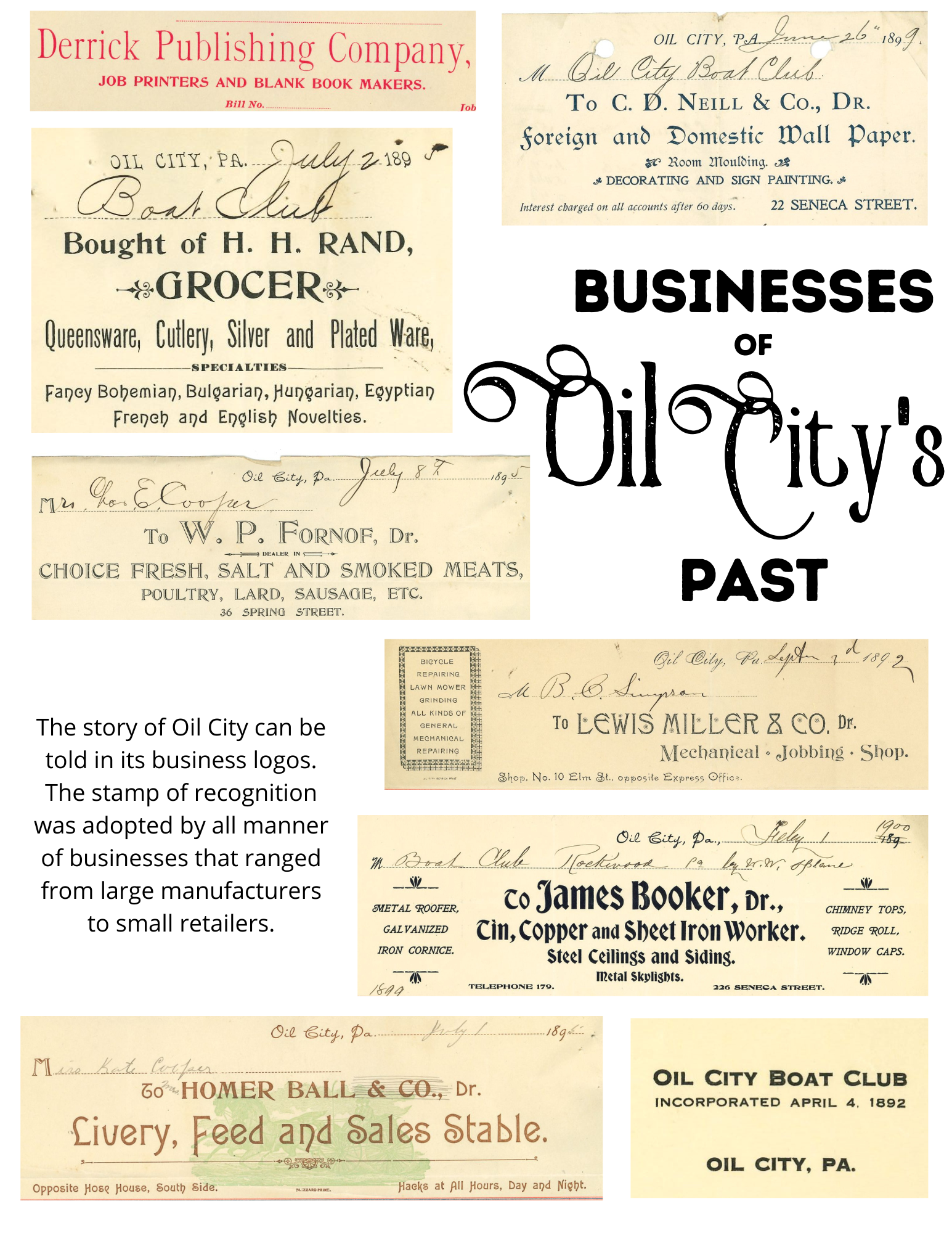The Greatest Show on Earth
- Judy Etzel
- June 18, 2021
- Hidden Heritage
- 2813
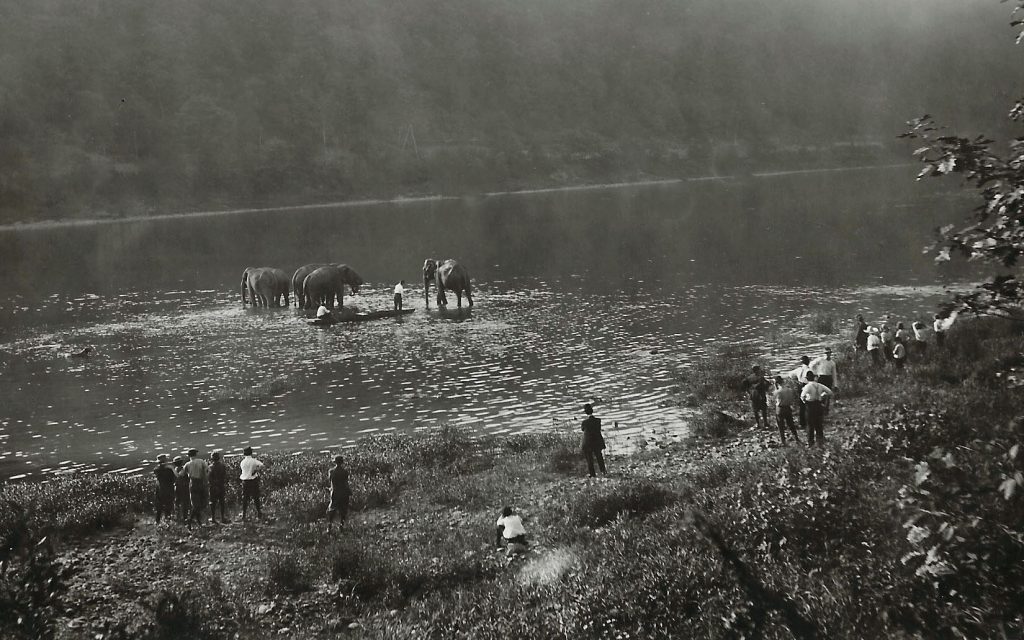
Four Oil City venues were used as sites for the traveling circuses. They were the old horse racing track (Bouquin Circle), the PNA ballfields on the North Side, the Keystone Grounds on North Seneca Street and the Segwick Grounds in the city’s West end.
Oil City was a top destination for the traveling circus shows. The popularity of the city as a prime venue on the national circuit was due in large part to leading citizens who had the financial wherewithal to pay the tab.
In addition, the city’s numerous clubs, whether social or fraternal or professional, stepped up to serve as sponsors for all types of entertainment. As a result, stage and movie personalities, athletes, musicians and more trouped through the city as part of their nationwide tours.
“Oil City was one of the best show towns in America,” noted a 1930s article in the national magazine “The Billboard.” Key among the attractions was the circus, an event that typically began with a full-scale parade in downtown Oil City and a multi-day listing of performances in two popular spots – the West End and the Keystone Grounds near the White Bridge on the North Side.
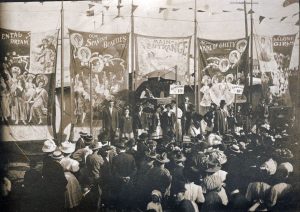
Circuses visiting Oil City typically featured a midway with lots of contests, sideshows, one-of-kind anomalies and more.
The first recorded circus appearance in the city was in 1872, one year after the City of Oil City was incorporated. The show was put on by Barnum & Bailey, a circus troupe that returned to the city in 1882, 1885, 1887, 1889, 1893 and 1906.
In 1893, The Walter L. Main Circus, another major entertainment group, set up a full-scale circus in the city.
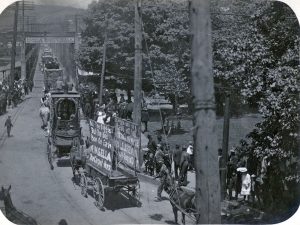
The circus parade makes its way across the Oil City Petroleum Bridge, replaced later by the State Street Bridge and then Veterans Bridge.
The Cole Brothers Circus visited in 1907. Ringling Brothers Circus came in 1906 and 1910. Several smaller circus groups, too, had national tours that included Oil City. Buffalo Bill’s Wild West Show put in an appearance in the city, too.
The circus extravaganzas continued, although with smaller companies, well into the 1950s in the city.
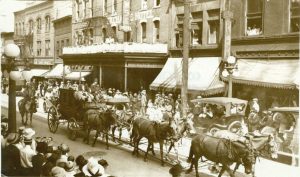
A parade of horses and stagecoaches makes its way along Seneca Street in Oil City. The Exchange Hotel on Seneca Street can be seen in the background.
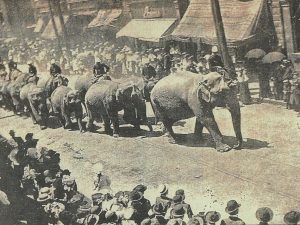
Elephants, the star attraction in all circuses, travel in a line along Center Street in this 1900 photograph. The circus in town then was the Walter Main Circus.
A Circus Tragedy
The King Brothers Circus finished up its show on Friday night, June 4, 1954, at the Seneca circus grounds and headed out to its next appearance in Warren. Early on Saturday morning, the string of circus vans, trucks and cars were heading down the Seneca hill when the brakes failed on rig hauling a large trailer carrying a dozen Palomino horses. The trailer pitched over a hill and into a creek near the bottom of the hill.
“Three Men Die in Circus Van Crash” blared a headline in the June 5 edition of The Derrick newspaper. Another headline reported that seven circus horses, too, had been killed.
The three men, ages 50, 31 and 18 years and all from out-of-state, were inside the horse van and crushed to death when the horses piled into the interior steel sides of the trailer.
In trying to rescue some of the 12 horses inside the trailer, Seneca volunteer firemen used torches to cut away the twisted steel. A fire suddenly erupted and more firefighters from Oil City were called to the scene. Hundreds of spectators dotted the hillside and roadway.
Two men – Tuffy Rodgers, assistant fire chief at Seneca, and Gordon Ziegler of Venus – were credited with rescuing three of the horses from the trailer before they could be burned to death.
Anna Chelton
Anna Chelton, considered the largest woman in the country, was born in Oil City. She lived at 401 Hoffman Ave. and was one of nine children born to Elroy and Anna E. Chelton. At the age of 17, Anna, who weighed 750 pounds signed a contract in 1913 to join a traveling circus show. A few years later, she joined a series of side shows and carnivals as “the world’s heaviest woman” and was known by her stage name of Elma Moore. She died at the age of 32 in 1918 of influenza and is buried in Grove Hill Cemetery. Her casket was carried by 10 pallbearers to her mother’s house where workmen had to remove an exterior side wall to move her body into the home for services. The entertainer had wished to have a band accompany her trek to the cemetery but it was not permitted because of the Great Influenza precautions in place.
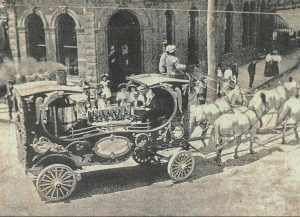
A long procession of circus animals and performers travel with the calliope at the corner of Center and Elm Streets.
It was not until five hours after the horse rescue operation began that firemen discovered a human body inside the trailer. It came as a shock because it was believed the trailer had been carrying only a dozen horses. Within a few minutes, two other bodies were discovered under the carcasses of the dead horses. The victims were crushed to death but also bore numerous wounds to their heads and bodies as a result of being kicked by the frightened and injured horses.
Two horses had escaped the trailer by jumping out and falling into the ravine. They were gathered up by spectators who led them to a nearby dirt road and tied them to trees. One horse that was badly injured was euthanized by a bullet fired by a state police officer.
An investigation revealed that the accident was caused by brake failure.
Written by Judy Etzel with research by Kay Dawson and design by Natalie Cubbon.

Four Oil City venues were used as sites for the traveling circuses. They were the old horse racing track (Bouquin Circle), the PNA ballfields on the North Side, the Keystone Grounds on North Seneca Street and the Segwick Grounds in the city’s West end.
Oil City was a top destination for the traveling circus shows. The popularity of the city as a prime venue on the national circuit was due in large part to leading citizens who had the financial wherewithal to pay the tab.
In addition, the city’s numerous clubs, whether social or fraternal or professional, stepped up to serve as sponsors for all types of entertainment. As a result, stage and movie personalities, athletes, musicians and more trouped through the city as part of their nationwide tours.
“Oil City was one of the best show towns in America,” noted a 1930s article in the national magazine “The Billboard.” Key among the attractions was the circus, an event that typically began with a full-scale parade in downtown Oil City and a multi-day listing of performances in two popular spots – the West End and the Keystone Grounds near the White Bridge on the North Side.

Circuses visiting Oil City typically featured a midway with lots of contests, sideshows, one-of-kind anomalies and more.
The first recorded circus appearance in the city was in 1872, one year after the City of Oil City was incorporated. The show was put on by Barnum & Bailey, a circus troupe that returned to the city in 1882, 1885, 1887, 1889, 1893 and 1906.
In 1893, The Walter L. Main Circus, another major entertainment group, set up a full-scale circus in the city.

The circus parade makes its way across the Oil City Petroleum Bridge, replaced later by the State Street Bridge and then Veterans Bridge.
The Cole Brothers Circus visited in 1907. Ringling Brothers Circus came in 1906 and 1910. Several smaller circus groups, too, had national tours that included Oil City. Buffalo Bill’s Wild West Show put in an appearance in the city, too.
The circus extravaganzas continued, although with smaller companies, well into the 1950s in the city.

A parade of horses and stagecoaches makes its way along Seneca Street in Oil City. The Exchange Hotel on Seneca Street can be seen in the background.

Elephants, the star attraction in all circuses, travel in a line along Center Street in this 1900 photograph. The circus in town then was the Walter Main Circus.
A Circus Tragedy
The King Brothers Circus finished up its show on Friday night, June 4, 1954, at the Seneca circus grounds and headed out to its next appearance in Warren. Early on Saturday morning, the string of circus vans, trucks and cars were heading down the Seneca hill when the brakes failed on rig hauling a large trailer carrying a dozen Palomino horses. The trailer pitched over a hill and into a creek near the bottom of the hill.
“Three Men Die in Circus Van Crash” blared a headline in the June 5 edition of The Derrick newspaper. Another headline reported that seven circus horses, too, had been killed.
The three men, ages 50, 31 and 18 years and all from out-of-state, were inside the horse van and crushed to death when the horses piled into the interior steel sides of the trailer.
In trying to rescue some of the 12 horses inside the trailer, Seneca volunteer firemen used torches to cut away the twisted steel. A fire suddenly erupted and more firefighters from Oil City were called to the scene. Hundreds of spectators dotted the hillside and roadway.
Two men – Tuffy Rodgers, assistant fire chief at Seneca, and Gordon Ziegler of Venus – were credited with rescuing three of the horses from the trailer before they could be burned to death.
Anna Chelton
Anna Chelton, considered the largest woman in the country, was born in Oil City. She lived at 401 Hoffman Ave. and was one of nine children born to Elroy and Anna E. Chelton. At the age of 17, Anna, who weighed 750 pounds signed a contract in 1913 to join a traveling circus show. A few years later, she joined a series of side shows and carnivals as “the world’s heaviest woman” and was known by her stage name of Elma Moore. She died at the age of 32 in 1918 of influenza and is buried in Grove Hill Cemetery. Her casket was carried by 10 pallbearers to her mother’s house where workmen had to remove an exterior side wall to move her body into the home for services. The entertainer had wished to have a band accompany her trek to the cemetery but it was not permitted because of the Great Influenza precautions in place.

A long procession of circus animals and performers travel with the calliope at the corner of Center and Elm Streets.
It was not until five hours after the horse rescue operation began that firemen discovered a human body inside the trailer. It came as a shock because it was believed the trailer had been carrying only a dozen horses. Within a few minutes, two other bodies were discovered under the carcasses of the dead horses. The victims were crushed to death but also bore numerous wounds to their heads and bodies as a result of being kicked by the frightened and injured horses.
Two horses had escaped the trailer by jumping out and falling into the ravine. They were gathered up by spectators who led them to a nearby dirt road and tied them to trees. One horse that was badly injured was euthanized by a bullet fired by a state police officer.
An investigation revealed that the accident was caused by brake failure.
Written by Judy Etzel with research by Kay Dawson and design by Natalie Cubbon.

